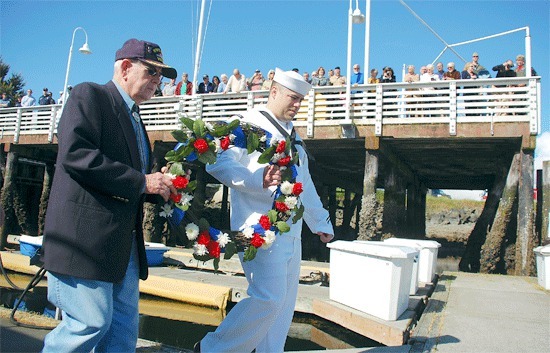Navy personnel, veterans and dignitaries from a variety of Island County governments convened at the Crescent Harbor Marina boat deck Friday to remember the Battle of Midway, one of the most significant naval engagements in U.S. history.
Quoting historian Walter Lord, Whidbey Island Naval Air Station Commanding Officer Capt. Jay Johnston said, “They had no right to win. Yet they did, and in doing so changed the course of the war. More than that, they added a new name, ‘Midway,’ to that small list that inspires men by shining example.”
The Battle of Midway was waged between U.S. and Imperial Japanese forces, from June 4 to June 7 in 1942. It was fought near a tiny island atoll that marked the midway point in the Pacific Ocean between the two warring nations.
The engagement saw the destruction of four of the six Japanese aircraft carriers that attacked Pearl Harbor six months earlier, along with one heavy cruiser. In all, 3,057 Japanese sailors were killed, including more than 100 pilots and more than 700 trained aircraft mechanics.
American forces suffered the loss of the aircraft carrier USS Yorktown, the destroyer USS Hammann and 145 aircraft. A total of 340 servicemen lost their lives.
The Battle of Midway is credited with being one of the most decisive victories in naval history. It’s also considered to have been the turning point in the war, as it prevented the Japanese from establishing a valuable foothold in the Pacific and derailed their offensive plans.
“The real story of Midway, however, is not one of aircraft, ships, grand strategy or geopolitics; it’s a story of people,” Johnston said. “From admiral to seaman, Midway Island was won by the courage, the skill, and the innovation of the American fighter.”
One of those fighters was Harry Ferrier, an Oak Harbor resident and retired Navy commander. Ferrier served with Torpedo Squadron 8, flying as a radioman and gunner in the Grumman TBF-1 “Avenger” during the battle. Out of 51 torpedo planes, Ferrier’s was in one of only seven that returned.
“I still think about all those young men who lost their lives,” he said.
Ferrier was very nearly killed himself when a bullet passed through the cap he was wearing during the battle. To emphasize just how close a call it was, the held up the hat with his finger through the hole while speaking at the podium.
“It came pretty close to taking me out,” Ferrier said.
The service was concluded with Ferrier and Navy officers laying a wreath in the water at the dock, followed by a playing of taps.
Attendees later recounted how meaningful the ceremony was. Tom Tack, a retired wing commander at NAS Whidbey Island and a Coupeville Town Council member, said he believes most people don’t realize just how significant Midway was.
“If we had lost that battle, where would we be and what would the world look like?” he asked.
“It’s just the perfect way to commemorate one of the most important battles in Naval history,” Tack said.



